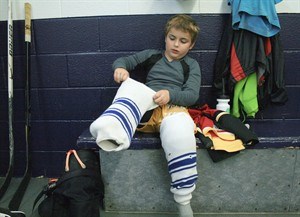
Six-year-old Shane Buchan gets dressed for hockey practice in Oakville, Ont., Friday, Oct.5, 2012. While NHL players are currently on the sidelines, countless youngsters will lace up their skates in the days and weeks ahead. And ensuring their equipment stays clean is key for reasons beyond staving off the stench. THE CANADIAN PRESS/Richard Buchan
October 11, 2012 - 2:09 PM
TORONTO - Long before Jonathan Toews struck gold with Team Canada or hoisted the Stanley Cup, the task of helping to clean and organize his hockey gear fell largely to his parents.
Bryan Toews fashioned a hockey tree from an old wooden coat rack, drilling in holes and sliding dowels through to hang the wide range of equipment that outfitted Jonathan, currently captain of the Chicago Blackhawks, and younger son David, who plays in the East Coast Hockey League.
His mother, Andree Gilbert, diligently washed the hockey gear for both sons by hand with detergent — but jerseys from championship victories destined to be framed were off-limits from laundering.
The hockey mom admits there's one part of the task that never got easier.
"You just can't used to that smell!" Gilbert said with a laugh during a recent interview.
Bryan Toews recalled taking precautionary measures to try and help combat the odour.
"I remember taking the Febreze bottle and squirting it in their bag or putting the fabric softener ... in the bag just to absorb the smell."
Toews's affable parents recently led media on a tour of the Canadian Tire Home of Hockey in Toronto. The event included a showcase of ways to keep equipment clean, tidy and organized, such as specialized bags equipped with vents and built-in fans to help air out and dry gear.
NHL players are currently on the sidelines due to the ongoing lockout. But across Canada, countless youngsters will soon be — or are already — lacing up their skates to take to the ice. And ensuring their equipment stays clean is key.
Nashville Predators equipment manager Pete Rogers said all the items players wear like T-shirts, shorts, pants, jerseys and socks are laundered each day, while equipment is typically disinfected daily. A Sani Sport machine — which he described as a "locker on wheels" —is also used, where equipment is treated with a deodorizing spray prior to running through a 22-minute cycle.
"At the professional hockey level, that equipment is being dried and maintained and cleaned so the smell isn't as bad as it is in, say, a youth hockey team, where some of these kids probably don't unzip their bags until they go to play the next time — and they're not drying it properly," said Rogers, president of the Society of Professional Hockey Equipment Managers.
Rogers said there isn't as much leather in the equipment as there used to be, and the odour that lingers in locker rooms isn't as bad. With players wearing more wicking fabrics, much of the sweat and moisture is drawn from their bodies as opposed to clinging to shirts, he added.
Certain types of bacteria such as anaerobes — which don't require oxygen to survive — don't smell very good, noted Dr. Michael Gardam, infectious disease specialist at the University Health Network in Toronto.
"They live in the moist crevices of the equipment, and over a while, it starts to stink because those are just the bacteria growing," he said.
Where trouble really arises with sports teams is when equipment is being thrown onto the floor or items are being jumbled in with someone else's, Gardam said.
"Now, you've got pieces of equipment touching each other or touching the bench or touching the floor, or people handling your equipment, and then you can start sharing bacteria between people.
"Professional sports teams are very aware of that," he added. "They are pretty cautious about cleaning their equipment and making sure that where they're hanging out has been reasonably cleaned and that sort of thing because there have been outbreaks."
San Jose Sharks captain Joe Thornton and retired player Mikael Renberg are among past and current NHL stars who've been sidelined by staph infections.
Gardam said over the last decade, there have been strains of the drug-resistant MRSA bacteria that have been passed from person-to-person, with the original reports happening with sports teams. Community-acquired MRSA can lead to illness or cause large boils to emerge on the skin, he added.
Early detection and diagnosis of MRSA can help limit the spread of the infection, according to the Public Health Agency of Canada. In addition to practising proper hygiene habits, the agency advises covering cuts and scrapes until they've healed, and not to share personal items, like towels and razors.
Gardam recommended keeping hands clean by washing with soap and water or an alcohol gel sanitizer, and cleaning equipment regularly in order to keep the microbial burden down.
"Just kind of be aware that people are carrying these organisms on their skin," he said. "Some of them are pathogenic, and if they're playing games like hockey, they could have a lot of these organisms on their pieces of equipment. So try to keep your stuff with your stuff."
News from © The Canadian Press, 2012